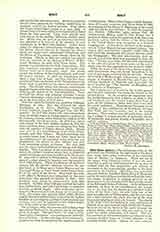

Holy Cross Abbey. — The picturesque ruins of this monastery are situated on the right bank of the River Suir, about three miles southwest of the cathedral town of Thurles, Co. Tipperary. While not one of the largest Irish Cistercian houses, it was the most beautiful in point of architectural details, as may be realized from the fine proportions and delicacy of treatment in the stone-carving, peculiar to the main portions of the building. This abbey was founded in the year 1169 by Donald O’Brien, King of Thomond, and in the order of dates was the eleventh of the forty-two houses established in Ireland previous to the Reformation by the disciples of St. Bernard, the monks of the Reformed Order of Citeaux. As its designation indicates, the fame of the establishment was mainly due to the fact that the church was enriched with a shrine of the Holy Cross, the relic being one of the most considerable in Christendom, and for over three and a half centuries the abbey was one of the most frequented pilgrimage places in Ireland. The church of the Holy Cross is cruciform in plan, consisting of chancel, nave, and transepts, with double side-chapels. Between two of the latter in the north transept the pillared shrine, wherein the relic was wont to be exposed for public veneration, still stands. This is a fine specimen of thirteenth-century carving and style, showing decided traces of French influence in its beautiful Gothic details. Among the more remarkable features of the monastic church are the east window, the groined roofing of the chancel and side-chapels, and the ribbed vaulting beneath the tower. All the windows are of different design, and are remarkable for the beautiful flamboyant treatment they illustrate. In the chancel at the Epistle side of the high altar is a structure not less interesting than the shrine in the north transept. While it apparently might have served the purpose of sedilia—having three divisions, composed of slender-pillared arches, surmounted with a canopy of elaborate tabernacle work—it is always styled the “tomb of the good woman’s son”. The frieze is further adorned with foliaged tracery through which are displayed the cross of St. George, the royal arms of England quartered with those of France, and other heraldic emblems of historic interest.
The relic of the Holy Rood, so long the object of the pilgrim’s veneration, is said to have been bestowed on this monastery by one of the Plantagenet queens of England in gratitude for the kind services of the abbot of the time in having the remains of her son (who met his death in the neighborhood of the abbey, while on a visit to Ireland) interred in the church. The erection of the tomb is ascribed to her, as also is the rebuilding of the abbey church, which surpassed anything of the kind in Ireland in its architectural splendor. Circumstances point to the fact that the young prince—”the good woman’s son”—was no other than “Pierce the Fair”, son of Isabella of Angouleme (widow of King John) by her second husband, Le Brun, Count of La Marche. He would therefore have been half-brother of Henry III of England. His death is recorded by the “Four Masters” as having occurred in Ireland, 1233. The Abbey of Holy Cross, as one of the greater monasteries, was suppressed under the fiat of Henry VIII in 1536. The abbot of the time, William O’Dwyer, surrendered on condition that he would enjoy the revenues for his lifetime. Eventually, Holy Cross with its appurtenances was conferred by Elizabeth on Thomas, Earl of Ormonde. However, we find as late as 1633 the Divine ministrations were still exercised in the church. The year 1632 was apparently the last during which the relic of the True Cross was exposed for public veneration. Subsequently, the community withdrew to Kilkenny city, where a private house was rented by the abbot, Right Rev. Luke Archer. Here they decided to await the coming of better times, but the hoped-for day of return to their monastery never came. The preservation of the abbey ruins is now the charge of the Board of Works (Ireland).
J. B. CULLEN

